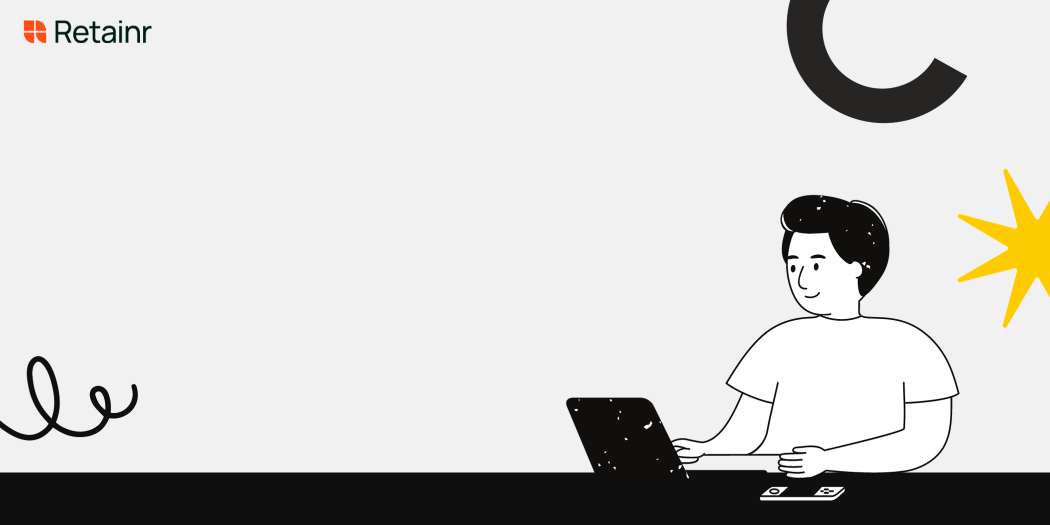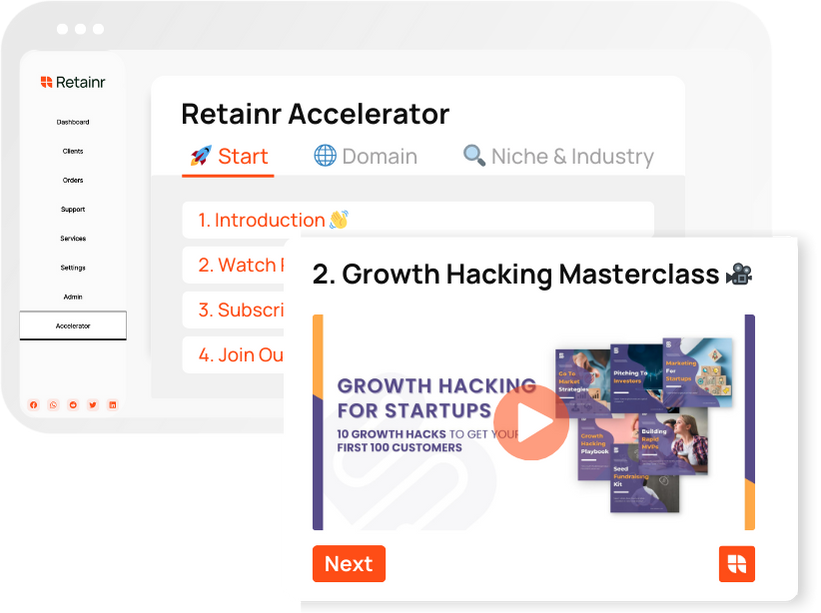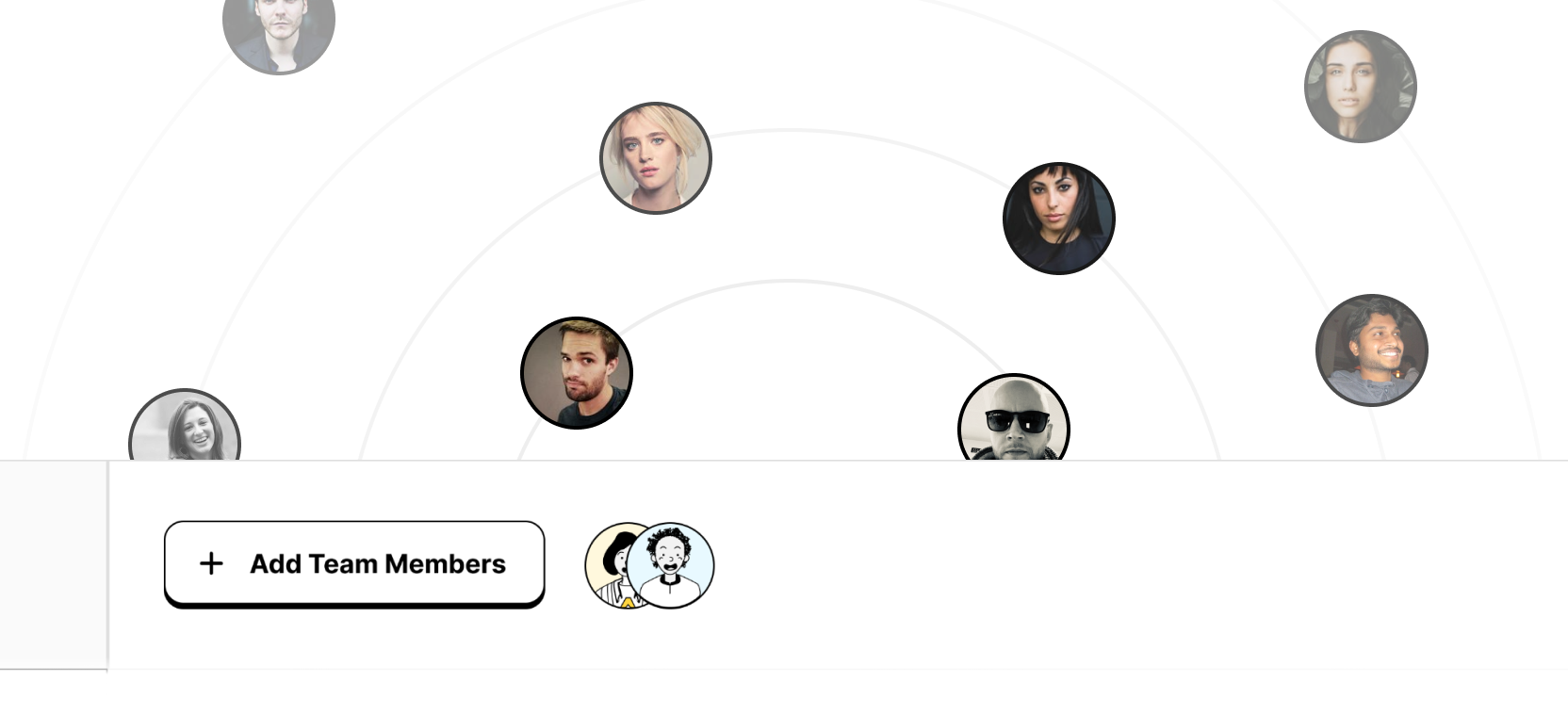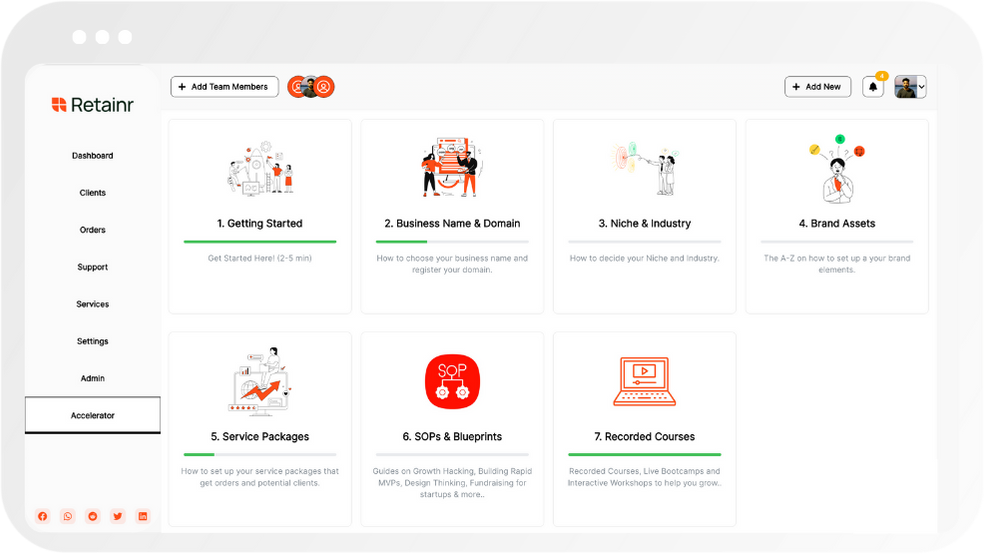
How to Create a Killer Portfolio: 8 Must-Have Elements
Build with Retainr
Sell your products and services, manage clients, orders, payments, automate your client onboarding and management with your own branded web application.
Get Started1. What are the 8 must-have elements for creating a killer portfolio?
Identifying the 8 Essential Elements of a High-Quality Portfolio
To design an effective portfolio that showcases your work and abilities, certain essential components must be included. These are the key elements that make a portfolio stand out:
- A personal logo or brand: It gives your portfolio a professional touch and makes it recognizable.
- Compelling Bio: An intriguing, brief bio can add a personal touch and make your portfolio stand out from the rest.
- Quality Work Examples: Display your best work. The quality of your work can grab the attention of potential clients or employers.
- Services and Capabilities: Clearly defining your skills and capabilities can give the viewer an idea of what you can offer.
- Contact Information: It's vital to include your contact information so stakeholders can reach out easily for more details or business proposals.
- Client Reviews: Including testimonials or reviews from past clients can enhance your credibility.
- Design Aesthetics: A well-designed portfolio appears professional and can create a strong initial impression.
- Advancement and Progress: Displaying how your work has progressed over time can show your versatility and commitment to growth.
Implementing the Must-Have Portfolio Elements
To effectively implement these elements in your portfolio, you can utilize a combination of text, images, and even multimedia. Balance is key — the design must be engaging without distracting from the information provided. Table-format can be used for presenting certain types of data like client reviews or list of abilities.
| Category | Details | |||
|---|---|---|---|---|
| Client Review | "The work delivered was above and beyond expectations." | |||
| Skills and Capabilities | Graphic Design, UX/UI Design, Web Development |
| Project Name | Type of Work | Date |
|---|---|---|
| Project A | Graphic Design | MM-DD-YYYY |
| Project B | Website Development | MM-DD-YYYY |
3. What type of work examples should I include in my portfolio?
Deciding What to Include
It can be overwhelming wrestling with what examples to include within your portfolio. The golden rule is - always include the most impressive and fitting work examples. Prioritize quality over quantity. Your portfolio should include:
- Professional work: This means work that you've done for clients or employers. If you are newbie, focus on demonstrating your skills with relevant course assignments or personal projects.
- Challenging projects: Provide examples that show you can handle complex tasks. This will prove that you can add value and work efficiently under pressure.
- Diverse skill-range: Show off your variety of skills. If you are a designer, don’t limit yourself to web designs - show logos, illustrations, and print layouts as well.
The Presentation
It's not what you display, it's how you present it. Each piece of work in your portfolio should give potential employers insight into your abilities and maturity as a professional. Here are some elements you could consider when structuring your portfolio:
| Element | Description |
|---|---|
| Title | Make the project name clear and brief. |
| Context | Give the project some background; explain when, why and for whom the work got constructed. |
| Role | Detail what your contribution was to the project. |
| Process | Provide step by step details on how you worked on the project. |
| Results | Highlight the success of the work. If applicable, include measurable results. |
Keeping it Fresh
Last but not least, remember to keep your portfolio up-to-date. Make a habit of reviewing and updating your portfolio regularly. Following this approach ensures that potential employers or clients always see your most recent and best work. Therefore, you might want to:
- Periodically update your skill list.
- Add recent projects regularly.
- Archive older projects.
- Update your bio and photo.
4. How can I make my portfolio stand out in a crowd of competitors?
Making Your Portfolio Stand Out
Creating a standout portfolio includes going an extra mile in enhancing the design, ensuring its uniqueness, maintenance, and universal appeal. This requires a collection of specific details that go beyond just showing your best work. Have in mind that your portfolio represents your brand, your skills, your dedication, and creativity. Here are some elements to include:
- A clear introduction: This provides a summary of who you are and what you do best. It helps the client get a glimpse of your uniqueness and professionalism.
- High-quality images: Ensure the images and designs are in their best quality, crisp, and appealing. This shows how keen you are on delivering quality work.
- Innovative design: The design layout of your portfolio can tell much about your creativity levels. Use an innovative and unique design that clearly displays your work.
- Reviews and testimonials: Positive feedback from previous clientele can significantly boost your credibility. It gives potential clients a sense of trust and confidence in your abilities.
Engaging Content
Besides the aesthetics and design, potential clients also look at the depth and quality of the content. Include case studies and stories about previous projects that show analytical thinking, problem-solving, attention to detail, and how you deal with challenges that might occur during a project. You might want to consider:
- Telling a story: Every project has a unique story, challenges, and how you overcame them. This humanizes your portfolio and makes it engaging.
- Detailing your approach: This gives the client a glimpse on how you handle your tasks, which could be an added advantage.
- Incorporating a blog: Include a section where you continuously give updates. This shows that you're not only active but also passionate about your profession.
Organized Presentation
It's crucial to ensure that your portfolio is organized in a manner that is user-friendly and guides the user intuitively. Consider creating different categories for different types of projects, or separate sections for different skills. Also, make sure all your contact details are easily accessible, and the UI/UX of the portfolio is clean and smooth. Below is an example of how you can organize your portfolio:
| Section | Content |
|---|---|
| Introduction | About Me, Client Testimonials |
| Portfolio | Graphic Design, Web Design, Illustrations |
| Blog | Latest Projects, Creative Insights, Industry Trends |
| Contact | Email, Phone Number, Social Media Links |
5. Are there any specific techniques to improving a portfolio's visual appeal?
Visual Appeal Enhancement Techniques
Improving your portfolio's visual appeal not only makes it more attractive but also boosts the chances of drawing attention and leaving a lasting impression on your clients. Here are some proven techniques:
- Consistent Color Scheme: A harmonious color palette makes your portfolio pleasing to the eye and conveys your personal style. Choose 2 to 3 primary colors that match your brand.
- High Quality Images: Use high-resolution, professionally-taken photographs or graphics. Poor image quality can be detrimental to the initial impression.
- White Space: Invites the viewer's eye to move easily through your content. Don't overcrowd your portfolio with information. Remember, less is more.
- Custom Typography: Unique typefaces add personality and are eye-catching without overpowering your work.
Decorative Elements
Below is a table that highlights some other decorative elements you can incorporate to enhance the visual appeal of your portfolio. Note, however, that the use of these elements should be minimal to prevent distracting your viewers from the main content.
| Decorative Element | Description |
|---|---|
| Shapes | Using shapes strategically can draw attention to specific sections or pieces of work. |
| Ribbons | Ribbons can be used to highlight specific features or achievements (like 'Award Winning', 'Best Seller' etc.) |
| Textures | Adding a texture to your portfolio's background adds depth and interest, as long as it doesn't clash with your work. |
| Borders | Borders can frame your work and separate different sections. |
Layout Consistency
Finally, maintaining layout consistency is fundamental in portfolio design. Your viewer should be able to intuitively navigate through your work. Even though you may have a diverse range of pieces, strive to showcase them in a clear, consistent style. This could include maintaining the same frame size for all images, positioning each piece in a similar way, and keeping the typography consistent throughout.
6. How should I organize my projects within my portfolio?
Organizing Your Projects Effectively
Knowing how your projects are organized in your portfolio is crucial to creating a killer portfolio. There's no one-size-fits-all approach, as the arrangement might depend on your industry, experience level, and the type of projects you have undertaken. However, considering your audience's perspective while doing this can help you decide which order would best suit your work. Here are some of the most common methods:
- Chronological Order: This approach can help you showcase your journey and growth over time. You start by placing your earliest project at the beginning, then following up with the more recent ones.
- Relevance to Job: If you are applying for a specific job, putting the most relevant projects at the forefront can grab the attention of the hiring manager.
- Most Impressive Work First: Highlighting your best work can leave a strong first impression and spur your viewers to want to learn more about your capabilities.
Considerations when Organizing Your Projects
However you decide to organize, there are key elements that should be evident in every project you include in your portfolio:
| Element | Description |
|---|---|
| Background | Provide context on the organization or client for which you completed the project, including the purpose of the project. |
| Project Overview | Give a brief description of the project, detailing what it is, your specific role, and the tools or processes used. |
| Outcomes | Highlight your achievements or the results of the project. Remember to provide objective evidence like feedback, impact metrics, or tangible change brought about by the project. |
| Visuals | Include images, screenshots, videos, or links to demonstrate the project. Visuals can help to illustrate your work better, making it easier for others to understand the scope and quality of your work. |
7. What kind of information should I include about each project in my portfolio?
Introduction to Project Information
Featuring your projects in your portfolio is not just about displaying the final product; it's about presenting the story behind its creation. Explaining what challenges you faced and how you surpassed them adds depth to your work, which can make your portfolio stand out. Thus, the information you include about each project is crucial.
Essential Project Details
You should consider including these key elements:
- Project Title: A concise, descriptive title that easily indicates what the project is about.
- Description/Summary: A brief explanation of the project, its purpose, and its context. For example, you might include information about your client and their industry.
- Your Role: Clarify what your specific contributions were. If you worked as part of a team, these details could help potential employers understand your skills and responsibilities.
- Completion Date: This shows how current your skills are, and whether your experience is recent.
- Skillset Used: List the skills or tools used in the execution of the project as this will highlight your competence areas.
Tabular Presentation
Presenting your project information in a tabular format can be more digestible and can help to keep your portfolio organized. Here's an example:
| Project Title | Description | Role | Completion Date | Skillset Used |
|---|---|---|---|---|
| ABC Website Redesign | Complete redesign of ABC company's website to improve user interface and experience | Lead Web Developer | January 2022 | HTML, CSS, JavaScript, UI/UX Design |
8. How often should I update my portfolio?
Frequency of Updating Your Portfolio
The frequency of updating your portfolio can greatly impact its effectiveness. It is recommended to revisit your portfolio at least every three to six months, but ideally, you should consider updating it whenever there is a significant improvement or change in your work. Each update should not just be about adding new works, but also about eliminating outdated or less impressive pieces. Always keep it fresh and relevant!
- Monthly: If you're working on short-term projects or activities that yield quick results, updating your portfolio monthly could be a good routine. This way, you're always showcasing your most recent accomplishments.
- Quarterly: For longer projects or roles that take several months to witness notable progress, a quarterly review and update of your portfolio could make sense.
- Annually: If your career advancements or project milestones are measured in years, then you might only need to update your portfolio on an annual basis.
Maintaining your Portfolio
Aside from just adding new content, maintaining your portfolio should also include checking all the links, fixing any broken ones, making sure the load time of your portfolio is optimal, and that it looks good on all screen sizes. Also, it’s essential to get feedback from others, as they might spot points for improvement that you might have missed.
| Tasks | Frequency |
|---|---|
| Adding new content | As per project completion |
| Removing outdated content | Every 3-6 months |
| Reviewing and fixing broken links | Monthly |
| Ensuring optimal load time | Quarterly |
| Checking for responsiveness | Quarterly |
| Gathering feedback | Every 3-6 months |
9. Can I include collaborative projects in my portfolio and how should I represent them?
Including Collaborative Projects in Your Portfolio
Yes, you can certainly include collaborative projects in your portfolio. In fact, they are an excellent way to demonstrate your ability to be part of a team and work collaboratively with others. But, it's essential to represent them accurately and ethically. This will ensure that potential employers or clients understand your role and contribution in the project.
How to Represent Collaborative Projects
Firstly, you should always include a brief explanation about the project and who it was for. Next, you must be clear and specific about your role in the project. Don't hesitate to use bullet points for this, like this:
- Conceptualization and design
- Prototyping
- Execution
- Completion of the final product
Wherever practical, mention the names of other team members involved and their roles in the project. This shows transparency and gives an idea of the team size and diversity of skills utilized in the project.
Use of Tables to Represent Collaborative Projects
You can use tables to illustrate the division of tasks and roles in your collaborative projects. For example:
| Team member name | Role | Contribution |
|---|---|---|
| Your name | Your Role | Succinct description of your contributions |
Remember, the key is to be honest and clear about your contributions. Including collaborative projects portrays an important facet of your working style and capability, making your portfolio enriched and diversified.
10. How can I use my portfolio to effectively showcase my skills and experiences?
Highlight Relevant Skills and Experiences
Your portfolio is the perfect platform to demonstrate your skills and experience. Start by listing all your core competencies and unique abilities that set you apart in your field. Then, illuminate these skills through diverse work samples. You could include projects you've led, problems you've resolved, or unique methodologies you've pioneered. A variety of examples will establish your portfolio as a comprehensive showcase of your capabilities.
- Leadership roles
- Project management
- Technical skills
Showcase Your Process
Besides showcasing the final output, exhibiting your process is also essential, as it gives potential employers insight into your problem-solving abilities. This could involve a step-by-step breakdown of a single complex project, from initial concept to final resolution. You could also offer case studies of how you handled specific hurdles. Such elements add depth to your portfolio, binds the diverse projects together and illustrates your approach to work more comprehensively.
- Initial concept
- Project development
- Solution implementation
- Results and feedback
Incorporate Feedback and Achievements
Inclusion of any recognition or feedback you’ve received for your work could elevate the credibility of your portfolio. This could be in the form of testimonials from previous employers or clients, awards, or recognitions. It adds a balance of subjective and objective success indicators to your portfolio, ensuring that it appeals on multiple levels.
| Testimonials | Awards |
|---|---|
| Feedback from clientele or employers | Recognitions earned for your work |
Conclusion
Creating a Killer Portfolio: Essential Elements
A robust, versatile portfolio is a crucial tool for any professional looking to impress prospective clients. Through this guide, you'll learn about the key elements to build an exceptional portfolio, ranging from including versatile exhibits of your work, showcasing your individuality with unique designs, reflecting on your skills through testimonials, to state-of-the-art features like chatbots and adaptive design. The motive is to give your audience every reason to consider your services.
Why Should you Use Retainr.io
To deliver the best client experience, it's crucial to manage your operations efficiently. Acknowledging this, Retainr.io provides a comprehensive platform to streamline your client management needs. You can sell, manage clients, orders, and payments with your own branded app. The software ensures you present a highly professional image to your clients.
Elements to Consider
- Variety and Sequencing: Start with your best work, include variety, end on a high note.
- A Unique Bio: A concise, clear bio reflects your personality and professionalism.
- High-Quality Content: Quality trumps quantity, always invest in top-notch content for your portfolio.
- Client Testimonials: Positive feedback provides social proof to potential clients.
- Contact Information: Make sure your contact details are easy to locate.
- Chatbots: Interactive chatbots provide immediate assistance to visitors.
- Adaptive Design: Ensure your portfolio is accessible on all types of devices.
- SEO-Optimized: A fully SEO-optimized portfolio increases visibility.
Create your impressive portfolio today and manage all your business needs efficiently with Retainr.io's white-label software. Emphasize showcasing your skills in a professional, user-friendly manner with these portfolio essentials and the assistance of Retainr.io.
Boost Your Agency Growth
with Retainr Accelerator
Uncover secrets, strategies, and exclusive blueprints to take your agency's growth to the next level — from marketing insights to effective presentations and leveraging technology.

SOPs, Cheatsheets & Blueprints
Leverage 50+ SOPs (valued over $10K) offering practical guides, scripts, tools, hacks, templates, and cheat sheets to fast-track your startup's growth.
Connect with fellow entrepreneurs, share experiences, and get expert insights within our exclusive Facebook community.
.jpg)

Join a thriving community of growth hackers. Network, collaborate, and learn from like-minded entrepreneurs on a lifelong journey to success.

Gain expertise with recorded Courses, Live Bootcamps and interactive Workshops on topics like growth hacking, copywriting, no-code funnel building, performance marketing and more, taught by seasoned coaches & industry experts.

.jpg)

.jpeg)


